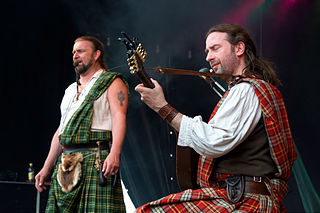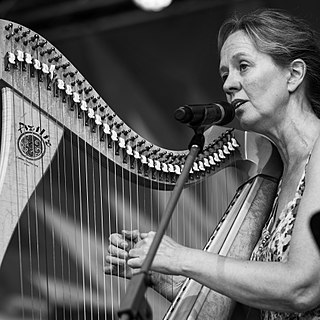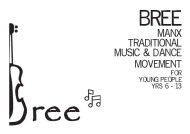
Celtic music is a broad grouping of music genres that evolved out of the folk music traditions of the Celtic people of Northwestern Europe. It refers to both orally-transmitted traditional music and recorded music and the styles vary considerably to include everything from traditional music to a wide range of hybrids.
The Goidelic or Gaelic languages form one of the two groups of Insular Celtic languages, the other being the Brittonic languages.

Ullapool is a village and port located in Northern Scotland. Ullapool has a population of approximately 1,500 inhabitants. It is located around 45 miles northwest of Inverness in Ross and Cromarty, Scottish Highlands. Despite its modest size, it is the largest settlement for many miles around. It is an important port and tourist destination. The North Atlantic Drift passes Ullapool, moderating the temperature. A few Cordyline australis are grown in the town and are often mistaken for palm trees. The Ullapool River flows through the town, which lies on Loch Broom, on the A835 road from Inverness.

Scotland is internationally known for its traditional music, which remained vibrant throughout the 20th century and into the 21st when many traditional forms worldwide lost popularity to pop music. Despite emigration and a well-developed connection to music imported from the rest of Europe and the United States, the music of Scotland has kept many of its traditional aspects and influenced many other forms of music.

The music of the Isle of Man reflects Celtic, Norse and other influences, including those from its neighbours, Scotland, Ireland, England and Wales. The Isle of Man is a small island nation in the Irish Sea, between Great Britain and Ireland.
The modern Celts are a related group of ethnicities who share similar Celtic languages, cultures and artistic histories, and who live in or descend from one of the regions on the western extremities of Europe populated by the Celts.
Highland English is the variety of Scottish English spoken by many in Gaelic-speaking areas and the Hebrides. It is more strongly influenced by Gaelic than are other forms of Scottish English.

The Celtic harp is a triangular frame harp traditional to the Celtic nations of northwest Europe. It is known as cláirseach in Irish, clàrsach in Scottish Gaelic, telenn in Breton and telyn in Welsh. In Ireland and Scotland, it was a wire-strung instrument requiring great skill and long practice to play, and was associated with the Gaelic ruling class. It appears on Irish coins, Guinness products, and the coat of arms of the Republic of Ireland, Montserrat, Canada and the United Kingdom.
The Scots Trad Music Awards or Na Trads were founded in 2003 by Simon Thoumire to celebrate Scotland's traditional music in all its forms and create a high profile opportunity to bring the music and music industry into the spotlight of media and public attention. Nominations are made by the public and in 2019 over 100,000 public votes were expected across 18 categories.

Patsy Seddon is a Scottish harpist, violinist, and traditional singer in Scots and Gaelic.
Mary Macmaster is a Scottish harpist and singer. She performs on the clàrsach and the Camac electroharp, and she sings in English and Gaelic. She has worked with Sting, Kathryn Tickell, Norma Waterson, Donald Hay, the Poozies, and in the duo Sìleas with Patsy Seddon. In 2013, she and Seddon were inducted into the Scottish Traditional Music Hall of Fame.

Lori Watson is a fiddle player and folk singer who performs traditional and contemporary folk music. She is the first doctor of Artistic Research in Scottish Music.

Mary Ann Kennedy, is a Scottish musician, singer, choral director, composer, radio and television presenter, and music producer.

Joy Dunlop is a Scottish broadcaster, singer, step dancer and educator from the village of Connel in Argyll, who now lives in Glasgow, Scotland. Singing predominantly in Scottish Gaelic, she performs folk music, song and dance in a contemporary style rooted in the tradition. She is a weather presenter for BBC Scotland and BBC ALBA and formerly a volunteer radio presenter with Oban FM
Phamie Gow is a singer, composer, harpist, 21st century pianist, film and creative director and international recording artist.

Ruth Keggin is a Manx Gaelic singer-songwriter. She holds degrees from the University of York and the University of Cambridge.
Roderick Morison, known as An Clàrsair Dall, was a Scottish Gaelic poet and harpist. He was born around 1646 in Bragar, Lewis and educated in Inverness, but he also learned to play the clàrsach as a profession. Later on, he moved to the Isle of Skye where he died around 1713. Morison is best known for his songs of praise for Gaelic aristocrats, for example MacLeod of Dunvegan and Iain Breac, MacLeod of Lewis.

Bree is a youth educational movement organised by Culture Vannin on the Isle of Man that gives children between the ages 10 and 18 the opportunity to learn traditional Manx music, dance, and culture. Bree is a Manx word that means 'vitality or 'energy'. The movement organises the annual workshop weekend every autumn and also runs monthly sessions through the year.
The Edinburgh International Harp Festival is an annual harp festival held in Edinburgh, Scotland that includes concerts, workshops, and courses, as well as one of the world's largest exhibitions of harp-makers. Organized and promoted by The Clarsach Society, two staff members, and a team of volunteers, the festival is held in April of each year and attracts more than 500 harpists from more than 25 countries.
Isobel Mieras is a Scottish clarsach player. She is a member of the Scottish Traditional Music Hall of Fame, and in 2020, she was appointed a Member of the Order of the British Empire "for services to Music in Scotland and to the Revival of the Clarsach."











